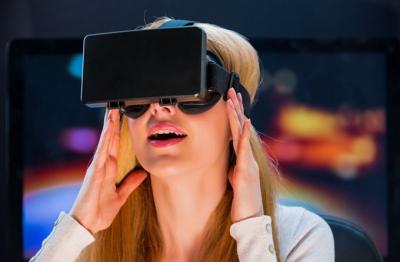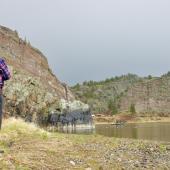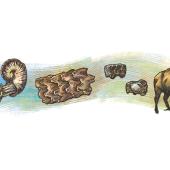Montana in 30 Years: Virtual Reality
Distinctly Montana Interview
We hear a lot about virtual reality and A.I. (artificial intelligence); but it would be helpful for you to give us a short description of both, and examples of how they are used in Montana today.
Artificial intelligence (AI) is an area of computer science that works to create intelligent machines that work and react like humans. AI includes the development of computer-based systems that perform human-like intelligence such as visual perception, speech recognition, and decision making.

One can think of virtual reality (VR) as simply meaning near-reality. The basic idea is to replicate the real-world using computer software and hardware. Virtual reality in technical terms is used to describe 3-D images generated by computers to create an illusion of presence (seeking to replicate sights and sounds) with an environment that isn’t really there. One application in Montana is at Montana State University where we use state-of-the-art driving simulators to study human driving behavior with the end goal of saving lives through better vehicle and roadway design. We also plan to utilize the newly release Oculus Rift head-mounted VR system within the classroom at Montana State University to teach engineering students better product design through a better understanding of human computer interaction concepts.
When we hear the term “virtual reality,” we naturally think of computer gaming or movies. Surely there must be more practical uses on the near horizon.
Virtual reality has many application domains, for example:
Architecture VR is used in exploring the best wayfinding strategy for users interacting with their environment.
Education Classrooms are utilizing VR to collaborate with classrooms abroad helping to bring cultures and a greater understanding among students of different ethnicities, recreations of historic or natural sites, engage students in topics of literature, history and economics.
Sports A golfer looking to improve their golf swing.
Healthcare As treatment for those with phobias (e.g fear of public speaking, fear of heights, etc., PTSD utilizing VR as exposure therapy, those with autism, to train novice surgeons to gain real world experience prior to actual surgery, non-surgical ways such as diagnostic training tool in X-rays, scan and blood tests.
Transportation Use of flight simulation to train pilots, VR is used to train novice drivers on hazard perception, test novel in-vehicle interfaces, how users will interact with semi and fully autonomous vehicles of the future.
VR Production is underway on certain Montana attractions, like the St. Helena Cathedral and the Lewis & Clark Caverns, which rely primarily on panoramic photography. How would one experience locations like that in 2046?
Currently VR primarily uses only two human senses (sight and sound) of the five traditionally recognized senses (sight, hearing, taste, smell, and touch). I imagine by the year 2046 engineers and computer scientists will have accomplished a way to replicate the other senses (smell, touch, taste) in a realistic manner. As a “virtual” visitor to the Lewis & Clark Caverns today you would only be interacting using 2-D panoramic pictures providing a less exciting experience than come 2046 when you either enter a “virtual reality cave” or you have a head-mounted display along with various other controls that will provide you a fully immersive experienced that will enlighten all your five senses. Just imagine, seeing, hearing, smelling, touching, and even tasting that cool cave air.
In the year 2046, what applications do you foresee for virtual reality systems in Montana, and how would such systems impact our economy?
I think there are many exciting applications for virtual reality systems in Montana, primarily in the area of tourism. I believe virtual reality could be a key component to marketing our beautiful landscape to potential visitors. Tourists from around the world could “virtually” experience Montana’s gems, such as Yellowstone, prior to their visits. Not only generating excitement in coming to the Big Sky state, but also in planning their trips. If well designed, the virtual reality system of tomorrow could be a major contributor to our tourism-based economy.
On the self-interest side, how will magazines like Distinctly Montana utilize VR in the distant future?
I imagine no longer will there be paper versions or 2-D generated images of magazines. Rather it will be one where the reader will virtually step into the story, to feel it and to experience it more intimately. Leaving a greater impression on the reader in the end.
OK, using your most wild imagining, what will the ultimate use of VR in Montana in 2046?
The ultimate use of VR would be one where you could see, touch, hear, smell, and taste locations elsewhere.
I think in the future VR could be used by the disabled and the elderly. We will see a greater emphasis in the area of physical rehabilitation, treatment of pain, improvement of cognitive functioning, social skills training, augmentation tool for those with developmental disabilities, communication and collaboration enhancements, and education.
Thrill seekers will have the ability to be immersed in activities that their more abled or younger counterparts experience throughout Montana. This may include virtually experiencing extreme skiing down the Big Coulier at Big Sky, hiking the ridge at Bridger Bowl, or experiencing the thrill of downhill biking. Or, on the less extreme side, the sensation of landing a beautiful rainbow trout while fishing or for those lovers of wolves , viewing bears, moose, etc. up close.
Thank you, Professor Stanley!












Leave a Comment Here